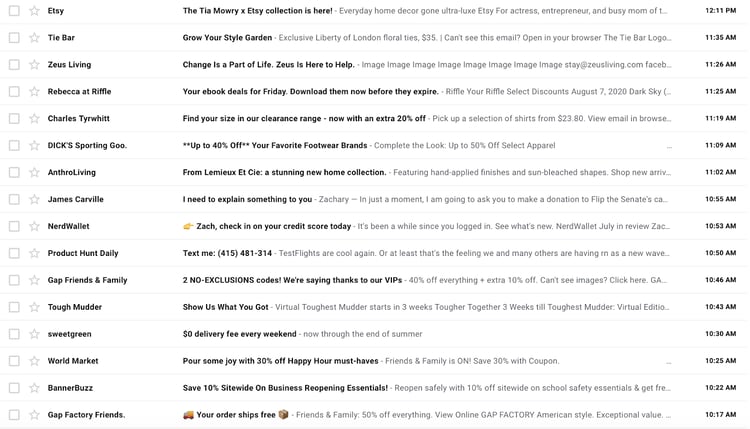The Copywriting Techniques Today’s Nonprofits Need to Know to Attract the Next Generation of Supporters

I never understood why my grandmother always received so many free gifts in the mail.
She was an incredible woman and all, but my ten-year-old self couldn’t wrap my head around the sheer quantity of colored envelopes and ornate packages addressed to her in any given week. And why was it always rosaries, prayer cards, and dream catchers she received?
I didn’t know it at the time, but this was my first introduction to the world of nonprofit donor acquisition.
Grandma collected her mail every day, but only read mail on Saturday mornings — accompanied by a piping hot cup of black coffee (never any cream...and definitely no sugar) and a couple of biscotti.
She’d open these envelopes, and completely read through the 2-, 3-, sometimes 4-page letters from (mostly Catholic) organizations asking her to “change a life for $50” or “help spread the Gospel in remote locations for $100/month.”
From there, she’d take out her checkbook and pick one or two organizations to give money to.
There may or may not have been a correlation between the organizations that sent her tchotchkes and the organizations that received money from her...but I can neither confirm nor deny that theory.
It should surprise no one that my grandmother and I operate quite differently.
She grew up in the early 40s, signed up for a Yahoo email at 60, and bought her first iPhone at age 70 — and I’m a 26-year-old who can barely remember what it was like to learn anything before Google. And yet, by and large, the ways in which nonprofits communicate with my grandmother and I hardly differ, despite our generational gap.
Sure, the channel might not be the same(for example, I rarely receive physical letters from a nonprofit, while I regularly get emails soliciting support), but the tone, the style, and the purpose of the communication is almost identical.
I spent a fair amount of time this week thinking about the advice I’d give to a nonprofit marketer who was hungry to reach into the pockets of a millennial like me…
And I drafted a solid B+ “5 Email Copywriting Tips for Nonprofit Communications Professionals” article.
But then I realized that there’s no way in heck I’d actually read the article I just wrote because I’m ridiculously skeptical of the value listicles bring to the blogosphere. So why would I expect anyone else to?
So, in the spirit of authentic millennial-ism, here’s the honest-to-God truth of what I wish nonprofits knew about how to communicate with me:
1. You’re Not Competing with 5 Letters in a Mailbox...You’re Competing with 50 Emails in My Inbox.
Here’s a real screenshot of my personal email inbox from this morning:

I estimate that I receive about 50 emails that make it into my inbox on any given day (not counting my G-Mail “Promotions” or “Social Tabs”).
When it comes to crafting your emails, your PRIMARY objective should be to get me to open your communication. It doesn’t matter how pretty your email template is, how moving the story you tell is, or how compelling your ask is if I never open the email.
Therefore, you should spend 80% of your time thinking about the subject line AND preview text of your email. Subject lines should inspire the user to want to know more...and preview text should give them a taste of the value they’ll receive upon opening.
Here are 3 tried and true techniques that have worked well for the Novus team and our clients lately:
-
Use ellipses in subject lines...they consistently perform better than ANY other punctuation mark
-
Craft preview text that builds upon your subject line. Try something like this:


-
Avoid using personalization in subject lines; instead, use it in the preview text (think about it...how often does one of your friends include your name in a subject line? Personalization in subject lines screams “from a brand”)
Your email is competing with communications from Banana Republic, Sweetgreen, ESPN, and my Aunt Nicole...how are you going to snag my attention long enough to get me to open your message?
2. Put Me at the Center of Your Communications...Not Because I’m Selfish, But Because I’m Privileged.
As much as my heart is moved by the photo of a young girl holding her brothers’ hand in an Indian slum, it’s incredibly hard for me to actually relate to her reality. The chasm between her day-to-day life and mine is just too wide.
That’s privilege for you.
Instead, tell me a story of a donor like me. What inspired him to become an advocate of your organization? How does supporting your mission better his life? What has he learned about the root causes of the challenges your beneficiaries face? Basically, show me how I can be part of making that young girl’s life better instead of overwhelming me by the wide gap between her situation and mine.
I’m also highly sensitive to anything that comes across as patronizing or exploitative...so craft your appeals within a framework of empowerment. I’m not saying you should never share the stories of people your organization helps; I’m saying you should share them in a way that’s intentional, authentic, and purposeful.
Charity:water has totally nailed their donor stories…check out these testimonials about their monthly donors from their website’s home page:



Using words, phrases, images, and stories that I can relate to is sort of like passive word of mouth.
Hear me out — if I can see myself in your donors, it’s a heck of a lot easier to understand the value of my support and the impact I might be able to make in partnership with your organization.
3. Eliminate Dead Ends and Capitalize on My Eyeball-Time After I Subscribe or Donate
Thank you pages and confirmation emails are some of the most powerful assets in a nonprofit marketer’s toolbox...and yet they often receive the least amount of creative effort.
Here’s the deal — triggered communications (think thank you/confirmation emails) receive 80-90% open rates. That’s the best open rate you are ever going to receive! And yet most of these emails go something like this:
Subject line: Thank you, Zach!
Preview text: We’ve received your donation…
Hi <Zach>, we’ve received your donation!
Thank you so much for your continued support of our mission. Below is a receipt for your records.
Sincerely,
Joe Schmo
Director of Development
Let’s take a moment to look back at that subject line/preview text combo — there’s really no need for me to open that email. You gave me everything I needed to know upfront...no click required. Missed opportunity!
Your thank you pages and confirmation emails should always include secondary and tertiary offers to keep me engaged with your brand. Session time (time spent on a domain’s website) is one of the best ways to increase your website’s organic search rankings.
Invite me to watch a video testimonial of one of your donors or program beneficiaries. Encourage me to download your latest impact report to understand where your organization allocates funds and why they do it the way that they do. Offer me a custom referral link so I can share your mission and vision statements with my personal network.
The worst thing you can do is lead me to a dead end.
4. Write Email Appeals Like You’d Read a Dr. Seuss Book to a 5-Year-Old
Growing up, Tuesday afternoons in the summer were my favorite days. My mother would bring my siblings and me to the local public library for storytime with Miss Barbara.
I will never forget how Miss Barabara read Dr. Seuss books. Every page was filled with suspense — and the intonation of her voice made it all the better.
Think about it. Dr. Suess books aren’t particularly short (averaging about 60 pages) but they only contain about 1,600 words on average! Dr. Suess was a master copywriter — he used just enough words on each page to keep his readers flipping to the next. No more, no less.
Your appeal emails should do the same. It’s one thing to have a powerful story; it’s another to be able to communicate it compellingly.
Dr. Suess wrote fun, powerful, life lesson-rich stories, but Miss Barbara made them come to life in a way that completely enthralled me...a fire alarm could have gone off and I would not have flinched.
That’s the kind of attention you want your email appeals to command.
A few takeaways here:
-
Write like you talk...your brand should have a voice. If it doesn’t, reach out to us and let’s find it together.
-
There is no guarantee that the user is going to read the next sentence (let alone the next word!). Your job is to entice them over and over and over to keep reading…
-
Test out one-sentence and one-line paragraphs. They totally work.
Why it’s Worth Crafting Compelling Content that Converts
Copywriting is hard. But you know why I love it? And why you should too?
Because it’s something that can dramatically move the needle with respect to your nonprofit marketing results without requiring (too many) additional resources.
Want to increase your reach on social media? You’re going to have to spend some cash money with Facebook.
Looking to inspire donors at your upcoming virtual event with a video? Time to call DD Studio and make an investment.
But if you can understand how to craft a compelling subject line, how to architect a great story within the confines of an email, and how to inspire additional engagement with your organization post-conversion, you can accelerate a prospective advocate’s journey from website visitor to donor.
You don’t need tchotchkes to win my dollar…(cough, Grandma, cough). You just need to craft your messaging so that it stands out, engages, and compels my attention. You need to communicate that you have a seat for me at your table….preferably through text.
We’d love to help you reach your fundraising goals and inspire more people to support your mission. Let’s connect and explore how we can be partners in good.
